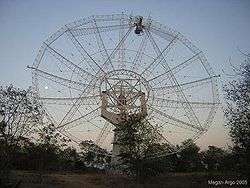Giant Metrewave Radio Telescope
 | |
| Location(s) |
Narayangaon, Maharashtra, India |
|---|---|
| Coordinates |
19°05′47″N 74°02′59″E / 19.096517°N 74.049742°ECoordinates: 19°05′47″N 74°02′59″E / 19.096517°N 74.049742°E |
| Organization |
National Centre for Radio Astrophysics |
| Wavelength | 50, 1,500 MHz (6.00, 0.20 m) |
| First light |
1995 |
| Telescope style |
Parabolic reflector radio interferometer |
| Number of telescopes |
30 |
| Diameter |
45 m (147 ft 8 in) |
| Collecting area |
47,713 m2 (513,580 sq ft) |
| Mounting |
Altazimuth mount |
| Website |
www |
 Location of Giant Metrewave Radio Telescope | |
The Giant Metrewave Radio Telescope (GMRT), located near Pune (Narayangaon) in India, is an array of thirty fully steerable parabolic radio telescopes of 45 metre diameter, observing at metre wavelengths. It is operated by the National Centre for Radio Astrophysics, a part of the Tata Institute of Fundamental Research, Mumbai. At the time it was built, it was the world's largest interferometric array offering a baseline of up to 25 kilometres (16 mi).[1] [2][3]
Location
The GMRT is located about 80 km north of Pune at Khodad. A nearby town is Narayangaon which is around 9 km from the telescope site. The office of NCRA is located in the Savitribai Phule Pune University campus.
Science and observations
One of the aims for the telescope during its development was to search for the highly redshifted 21-cm line radiation from primordial neutral hydrogen clouds in order to determine the epoch of galaxy formation in the universe.[4]
Astronomers from all over the world regularly use this telescope to observe many different astronomical objects such as HII regions, galaxies, pulsars, supernovae, and Sun and solar winds.[1]
Activities
Each year on National Science Day the observatory invites the public and pupils from schools and colleges in the surrounding area to visit the site where they can listen to explanations of radio astronomy, receiver technology and astronomy from the engineers and astronomers who work there. Nearby schools/colleges are also invited to put their individual science experiments in exhibition and the best one in each level (primary, secondary school and Jr. college) are awarded.
Visitors are allowed into GMRT only on Fridays in two sessions - Morning (1100 hrs - 1300 hrs) and Evening (1500 hrs to 1700 hrs). The GMRT is open to the public on National Science Day.
References
- 1 2 Ananthakrishnan, S. (1995). "The giant meterwave radio telescope" (PDF). Journal of Astrophysics and Astronomy. 16: 433. Retrieved 27 June 2015.
- ↑ Ishwara-Chandra, C H; Rao, A Pramesh; Pandey, Mamta; Manchanda, R K; Durouchoux, Philippe (2005). "Low Frequency Radio Observations of GRS1915+105 with GMRT". Chinese Journal of Astronomy and Astrophysics. 5 (S1): 87–92. arXiv:astro-ph/0512061. Bibcode:2005ChJAS...5...87I. doi:10.1088/1009-9271/5/S1/87.
- ↑ Swarup, G., Ananthkrishnan, S., Kapahi, V.K., Rao, A.P., Subrahamanya, C.R., and Kulkarni, V.K. (1991) "The Giant Metrewave Radio Telescope", Current Science, vol. 60, pages 90-105.
- ↑ Kapahi, V. K.; Ananthakrishnan, S. (1995). "Astronomy with the giant metrewave radio telescope (GMRT)" (PDF). Bulletin of the Astronomical Society of India. 23: 267. Retrieved 27 June 2015.
External links
| Wikimedia Commons has media related to GMRT. |